Dr. Jeff W. Childers, Carmichael-Walling Professor of New Testament and Early Christianity in the Graduate School of Theology at Abilene Christian University, offers some reflections on his recent trip to Saint Catherine’s Monastery at Mount Sinai:
Out of Egypt
________________________________________________________________________________________________________________________________________
For a book nerd like me, it was a dream come true. In my hands I held a volume whose well-thumbed margins had grown dark from generations of reverent use. Scattered across the table-top in front of me were numerous fragments from books that had fared less well, bearing the scars of centuries—tears, stains, and the accretion of desert soil. Some had only recently come to light; some were even awaiting identification.
After years of expectation, months of planning, and weeks of uncertainty due to the precarious political situation in Egypt, in late February 2011 I had journeyed at last to Mount Sinai, as the latest in a long stream of pilgrims searching for wisdom in ancient texts from the holy mountain.
St. Catharine’s is the oldest Christian monastery in the world still in use for its initial purpose. Its library is nearly unparalleled—only the Vatican has more ancient Christian manuscripts. This remote outpost of Christian learning and desert spirituality, set in the arid climate of the Sinai wilderness, turned out to be well suited for the preservation of books written there and from other places. Bible students everywhere have heard the story of Tischendorf’s 19th-century “discovery” at St. Catharine’s of the celebrated Codex Sinaiticus, containing the oldest complete copy of the New Testament. Yet the monks of St. Catharine’s are the guardians of many other extraordinary texts as well, and it was to gain a look at some of these that my research brought me to Mount Sinai.
Along with manuscripts in many other languages the Library holds a remarkable collection of Syriac texts. A dialect of Aramaic, Syriac is a language used by a number of early Christian communities throughout the middle-east. Today Syriac-speaking Christians are still proud to have Jesus’ native language as their own mother tongue and language of worship. Among the many original texts and translations that survive in Syriac, the versions of John Chrysostom’s 5th-century commentary on the New Testament have caught my attention—especially his homiletic commentary on the Gospel of John. Despite their early date and rich content, the Syriac manuscripts of this patristic commentary have never been edited, translated, and published, much less thoroughly studied. But in order to make them available to a wider readership, it is necessary first to gather the data from their ancient resting places in various places around the world—including the archives of St. Catharine’s monastery. The Sinai collection includes several manuscripts containing portions of the commentary, some of which have only recently come to light as part of the monastery’s “New Finds,” that are still in the process of being catalogued.
Upon learning of my interest in the collection, the Archbishop and the Holy Council of Fathers invited me to visit Sinai and use the Library. With the gracious and capable assistance of the librarian, Father Justin, I spent many hours poring over parchment books and fragments copied centuries ago, drinking in their biblical meditations, transcribing the texts, comparing them to each other and to texts found elsewhere. As a bonus, my daughter Rebekah accompanied me to St. Catharine’s, where she conducted interviews of the monks, gathering living data for her senior Honors capstone project at ACU on “Thin Places and Holy Sites.” Each day we worked side by side in the venerable monastery, taking advantage of prescribed breaks to join the monks for worship, to enjoy the art and gardens of the monastery, to become better acquainted with the local Bedouins, and to climb the rugged Mount Sinai (7498 ft.) together. It was an unforgettable and enriching experience.
As for the Syriac Chrysostom, it will be some time before I can assess and prepare all the data for eventual publication, yet it is already apparent that the evidence from Sinai is even richer than I had supposed. I am grateful to the monks, and for the financial support of ACU and the Loeb Classical Foundation that helped make the trip possible. But I am especially grateful for the faith of Christians of long ago, whose diligent labors in copying and preserving these ancient books has ensured that the testimony of past believers may still edify us today.
Dr. Jeff Childers
Carmichael-Walling Chair of NT and Early Christianity
ACU Graduate School of Theology
Abilene, TX 79699
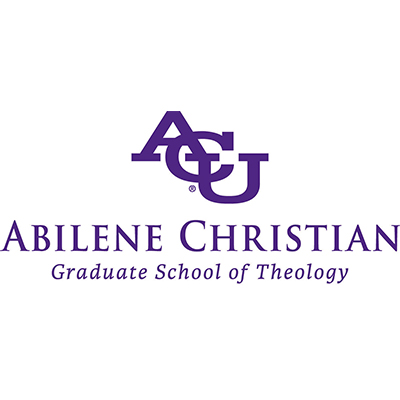
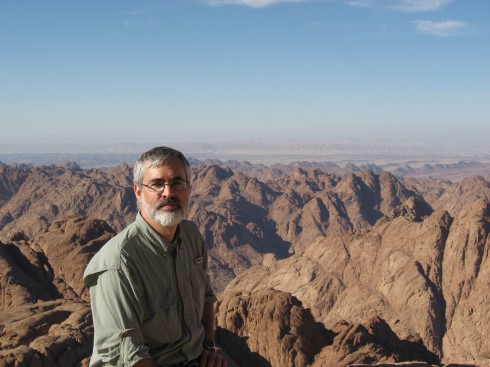
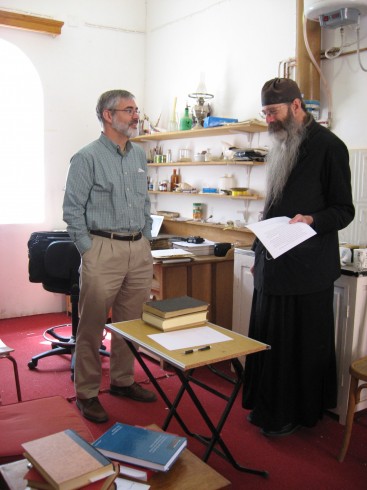
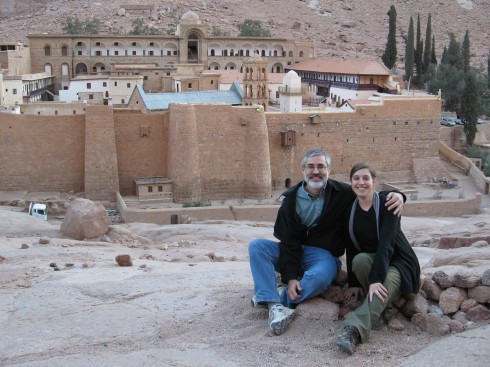
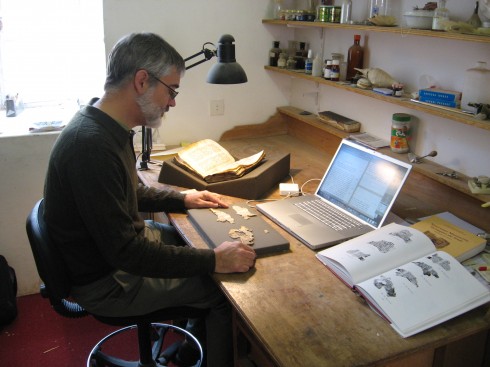
Dr. Childers,
Thanks for posting your experiences! I’m looking forward to hearing more about it when I take Syriac when you come back.
Peace,
James
That’s what I like to hear — the more syriacists there are in the world, the better.
Jeff,
I’m glad you and your daughter were able to make the trip together! What an experience! I’ve made Israel, Jordan, Turkey and Greece… Egypt is next! I must buy the BBQ next time I’m in Abilene to hear more about it!
Blessings!
Doug
PS – Maybe you could get John Chrysostom’s homiletic notes notes on John finished before my Gospel of John sermon series next year? 🙂
John Chrysostom has good stuff, but very challenging, morally — and he is especially tough on the affluent.
Wow! Cool resort! Do they have a pool?
Water is surprisingly scarce…
But you didn’t mention that father Justin is originally a fellow Texan! Wonderful glimpse of your journey–thanks!
Dear Dr. Childers,
My son-in-law Richard Dennis forwarded to me the account of your trip.What a wonderful thing–to have access to an unpublished work of Chrysostom. A great chhristian writer. Is this an unknown work?
It is not an unknown work. But so far our data has been based on relatively late witnesses.
Dear Jeff,
It’s lovely to hear about your work on Syriac version of Chrysostom’s commentary on John from Sinai manuscripts. And to see the lovely pictures too. How many sources will you use for your edition?
Gareth.
I have identified about 20 sources surviving in a number of different places, some of them very fragmentary, others fairly complete. The most full ones are the earliest, which is nice.
Can you exerpt the section on John 7:53-8:11?
It would be great to get a bead on Chrysostom’s position re: the PA.
peace
Nazaroo
Nice! As you may know, that passage is not in Chrysostom’s Bible at all.
Dear Mr. Childers,
May I ask you if you are still working on the Georgian text of the Acts of the Apostles, and if so, have you collated the text of Acts in the Georgian manuscripts of the Sinai New Founds ? And finally, do you think your book on the Georgian Acts of the Apostles will be published soon ?
I did look at some Georgian texts at Sinai and still keep my hand in things Georgian. Please email me and we can catch up on this in more detail: childersj@acu.edu
Great seeing you last night, and hearing a little more about this trip. Hoping Hilary and I can have you and Linda over soon.
blessings,
dps
I so desperately want to participate in a “write the caption” contest for the second photo.
So glad you and Rebekah got to do this!